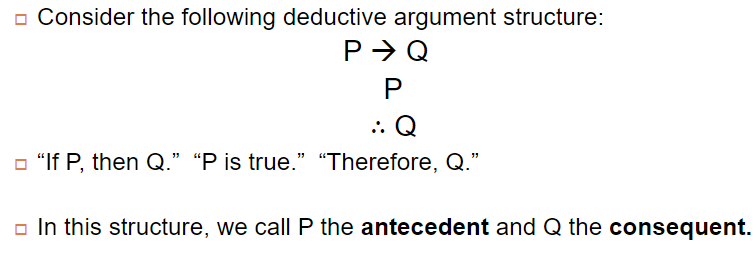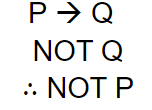PSY 324 final
1/85
There's no tags or description
Looks like no tags are added yet.
Name | Mastery | Learn | Test | Matching | Spaced |
|---|
No study sessions yet.
86 Terms
deductive reasoning
rigidly structured argumentation which, if accepted, must absolutely be true, strongest when both valid and true. Requires perfect information to be valid and sound
inductive reasoning
structured argumentation (can be reasoned but not necessarily) which if accepted is probably true. can be used when an argument can validly support a conclusion without completely confirming it, one may employ inductive reasoning

What is this argument structure?
Modus Ponen

What is this argument structure?
Modus Tollens

What is this common error human deduction?
Denying the Antecedent

What is this common error human deduction?
affirming the Consequent
Watson (1966)
studied the psychology of reasoning, specifically common errors in human deduction (denying the antecedent and consequent)
What is an error with inductive reasoning
base rate neglect
base rate neglect
we do not know the base rate and assume it to be great even though the true probability may be lower
Language
means by which humans interact with each other
Noam Chomsky
believed that humans are endowed with universal grammar
Universal Grammar
some set of structural rules are innate. A unique capacity to interpret grammar
Poverty of Stimulus
the theory that children receive insufficient linguistic input to fully acquire their native language without innate grammatical knowledge.
Phoneme
refers to the smallest unit of sound in language, often but not always represented by alphabetic letters
Morpheme
represents the smallest units of meaning in language
Bock 2000 and Levelt 1989
shows evidence suggests words are ordered before determining how to pronounce them
Coarticulation
Phonemes aren’t entirely separate either, they are blended together. when a consonant is pronounced, a vowel sound is attached to it automatically
What are the two competing theories on speech perception?
Motor Theory and Auditory theory
Motor Theory
(Liberman and Mattingly, 1985), the systems associated with perceiving and producing speech are closely related. Speech perception is innate and species-specific
Evidence for Motor Theory
Categorical perception
Categorical Perception
the delay between the physical motions of speech and the vibrations of the vocal chords can dictate how listeners identify phenome sounds. the areas of the brain associated with with speaking are stimulated when listening to speech. demonstrates that speech perception relies on motor system
Auditory Theory
speech perception is derived from the properties of the auditory system. this is not species-specific
Evidence for auditory theory
not species-specific, categorical perception functions in chinchillas similar to humans
the place of articulation (ex. closed lips or tongue location) of a consonant can be reliably predicted using only the sounds made by the consonant
Kuhl and Miller (1978)
not species-specific, categorical perception functions in chinchillas similar to humans
Syntax
ordering of words and their relations, interpretations can even be different for identical strings of words
Kim et al (1991)
evidence that there is a psychological basis to the grammatical categorization of words
Slobin (1966)
humans favor active over passive sentences
Broca’s area
associated with the production and expression of language
Wernicke’s area
associated with the comprehension of language
What are the four aspects of a problem?
goal, givens, means of transforming conditions, obstacles
Goals
an end state or solution being pursued which can be determined as solved by some criterion
Givens
objects, conditions, and constraints associated with a problem
Means of transforming conditions
the problem must be practically solvable, so there must be a way to change the situation
Obstacles
some difficulty must exist which inhibits finding the solution
Well-defined problems
the conditions and aspects of the problem are clearly specified without ambiguities or uncertainties
Ill-defined problems
he conditions and aspects are not clearly specified. Ambiguities and uncertainties cloud the paths to the goal
How can problem-solving be reliably investigated?
intermediate products, verbal protocols, computer simulations
Intermediate products
researchers log the steps a solver takes on the way to a solution
Verbal protocols
researchers ask participants to “think aloud” as they work through a problem
Computer simulations
researchers build a program that mimics the problem-solving process
Newell and Simon (1972)
among the best known researchers of problem solving
Task environment
refers to the objective factors of a problem outside of cognitive processes
Problem space
refers to the mental representations of the task environment wherein the problem-solving process occurs
Problem state
refers to a past, present, or future state in the problem-solving situations
Problem operator
refers to the means by which a problem solver can move from one state to another
Algorithm
a systematic procedure which is certain to produce a solution to a problem. involves searching all possible problem states to derive a solution. perfectly reliable, but sometimes immensely time-consuming. often intractable for the human mind
Heuristic
a method that can direct a partial search to find pertinent problem-state information. More efficient than algorithms but do not guarantee a solution
Hill Climbing
an example of a Heuristic, with this method, at any given point in a problem space, one must simply choose the next state closest to the goal
Problem with Hill Climbing
not always the most efficient
Means-end analysis
the problem solver reviews numerous problem operators available and identifies which one best reduces the distance to the goal
Problem with means-end analysis
all possibilities may not be accounted for nor assessed
Functional Fixedness
an inability to use objects for purposes other than their intended functions or designs
Heuristics in Decision Making
when confronted with some hindrances to the decision-making process, humans will employ heuristics to simplify the choice. cognitive shortcuts or biases which can be useful in arriving at decisions
Availability Heuristics
when making decisions we are biased by what comes to mind first
Representativeness heuristics
cases in which an event is judged to be more likely if its features or properties are more like its categories
Conjunction fallacy
the inclination to choose a conjunction of answers rather than the more mathematically accurate choice
Anchoring and adjustment
people make estimates based on some starting or baseline value, and adjust from that point with new information
Ariely, Lowenstien and Prelec:
SSN and sound study as evidence for Anchoring and adjustment
Normative models (rational models)
assumes humans are rational beings. these attempt to predict how humans ought to behave it what would be most optimal
what two rational principles play a significant role in normative modeling?
Transitivity and Non-contridiction
Transitivity
If A is preferred over B, and B is preferred over C. Then A is preferred over C
Non-contradiction
if A is preferred over B, B is not preferred over A
Expected Value theory
was an early model in economics designed to predict how people determine monetary value. Values are calculated by arithmetic
Problem with Expected Value theory
does not successfully predict how humans determine monetary valuations
Expected Utility Theory
Values are calculated by arithmetic but utilities (specific goals of a person) is considered
Violations of Expected Utility Theory
certainty effect, preference reversals, Context effects
Certainty effect
biased in favor of prospects that are guaranteed
Preference reversals
refer to cases in which decision makers value A over B, but still choose B (or give it greater weight in some way)
Context effect
arise when people’s choices are impacted by the relationship between the options available
attraction effect
when an object is better than another object in all dimensions, we are most likely to choose it even if there is a “better” option
Framing effect:
arise when utility decisions are impacted by the manner in which the options are presented
Sunk costs
After the investment is made, if large enough, one is more inclined to stick to it even if it isn't working out
Descriptive models
these attempt to predict actual human behavior without regard for what is optimal
bounded rationality
a principle which suggests humans can’t make perfect decisions, but they can usually make pretty good decisions
Prospect Theory
an adjusted expected utility with the hopes of accounting for the various non-normative tendencies observed in human decision making data. replaced objective probabilities in expected utility with subjective psychological probability
Regret Theory
People will choose a less rational choice if the other choice is a guarantee
Are we more biased by loss or gain?
loss
when a problem is framed in terms of losses, how do people tend to be?
risk-seeking
When a problem is framed in terms of gains, how do people tend to be?
risk-averse
Expected Value theory
Normative
Expected Utility Theory
Normative
Prospect Theory
Descriptive
Regret Theory
Descriptive
Optimizing
Examine all options and choose the best one
Satisficing
Decision maker will decline to investigate every possible option, only a smaller subset will be reviewed instead
Elimination by aspects
some aspect of the options is considered, and any option not meeting a criterion is eliminated. this process is repeated until one option remains